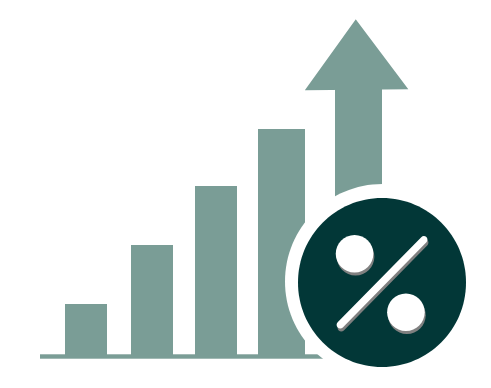Alert:
Interest Rates and How They Impact Your Finances
Interest rates may have an important impact on your finances in the following ways:
- Borrowing Costs: When interest rates are high, the cost of borrowing money through loans, credit cards, or mortgages increases. This means you'll pay more in interest over the life of the loan, possibly leading to higher monthly payments. Paying down your debt helps deal with a rise in interest rates.
- Earnings on Savings: Higher interest rates can benefit your savings. When you deposit money in savings accounts, or other interest-bearing accounts, you can earn more on your savings, which can help your money grow faster.
- Investment Returns: Changes in interest rates can significantly affect different types of investments.
- Savings and Guaranteed Investment Certificates (GICs)
When borrowing rates increase, financial institutions have more room to offer competitive interest rates on their savings accounts and GICs. Rising interest rates make the yield on GICs more attractive. - Equity funds and Stocks
When interest rates rise, stock markets typically decline. Because borrowing becomes more expensive, people and businesses tend to spend less. This decreased spending may mean companies hire less or have layoffs, see lower productivity and face reduced earnings. These effects often cause stock prices to fall. - Bonds and Bond funds
Government and other bonds give you a fixed rate of interest and return your initial investment at maturity. Bond prices and interest rates usually move in opposite directions. This means that if you have bonds or bond funds the market value of these investments will usually go down when interest rates rise and go up when interest rates fall. A bond may offer higher yields (that is, generate higher earnings) when markets expect an increase in rates. - Margin Accounts and Leverage
A margin account is a brokerage account that lets you access more funds by borrowing against the value of your investments. The funds are loaned to you based on an interest rate that changes every so often. Because rising interest rates mean a rise in the cost of borrowing, you have to pay more to borrow against your existing investments.
- Savings and Guaranteed Investment Certificates (GICs)
- Inflation: Many factors impact interest rates; inflation is one of the more important. When inflation is high, a central bank, like the Bank of Canada may raise interest rates to help control how people spend money. High inflation eats away the purchasing power of your money and can affect your savings and investments.
- Retirement Planning: Interest rates can impact your retirement planning, as they affect the returns on investments in your retirement account. Low rates can make it difficult to generate the necessary returns to fund your retirement.
- Student Loans: If you have student loans, the interest rate on those loans can affect the total cost of your education. Federal student loan interest rates are usually tied to market rates, so they can change over time.
- Refinancing Opportunities: Changing interest rates can create opportunities for refinancing existing loans. When rates drop, you can refinance to lower your costs. Rising rates may limit your ability to refinance at favorable terms.
- Economic Conditions: Interest rates are an indicator of overall economic health. When rates are low, it can stimulate borrowing and spending, benefiting your financial situation. High rates can slow economic growth and lead to job market challenges.
Understanding Interest Rates

These are the rates that investors should pay close attention to:
Policy rate
When you hear rates have climbed by 0.25%, they are referring to the policy rate (also known as the overnight lending rate). The policy rate is set by the Bank of Canada and affects the rates set by other banks for borrowing.
Prime rate
Another rate you hear about is the prime rate. This is the rate that banks charge their best clients or clients with good credit for borrowing funds.
Types of interest rates
There are many different types of interest rates. Here are some examples:
| Simple vs. compound |
For simple interest, the borrower pays the lender the interest owing on the initial principal at certain times. Bonds and short-term GICs usually work this way. Other debt arrangements, such as High Interest Savings Accounts (HISAs), usually have compound interest, which means the issuer pays interest on previous years’ interest as well as the principal. |
| Fixed vs. variable |
| With a fixed interest rate, the rate stays the same over the term of the loan. With variable interest rates, the interest paid may be changed by the lender (go up or down), depending on how high or low the policy rate goes. |